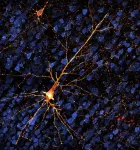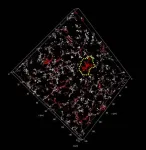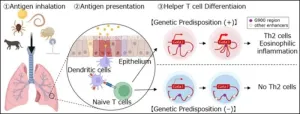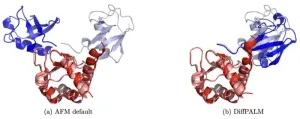(Press-News.org) Research in nonhuman primates is opening the possibility of testing treatments for the early stages of Alzheimer’s and similar diseases, before extensive brain cell death and dementia set in. A study published June 21 in Alzheimer’s & Dementia: The Journal of the Alzheimer’s Association shows up to a six-month window in which disease progress could be tracked and treatments tested in rhesus macaques.
“This is a very powerful translational model to test interventions that target the tau protein,” said John H. Morrison, professor of neurology at the University of California, Davis and California National Primate Research Center and corresponding author on the paper.
The tau protein is found in neurons in the brain. The spread of misfolded tau through the brain is implicated in Alzheimer’s disease, frontotemporal dementia and other dementias. In Alzheimer’s, misfolded tau disrupts multiple processes essential for normal brain cell functioning. As the misfolded proteins spread, they affect neurons throughout the connected regions of cortex that are crucial for memory and cognition.
The sick neurons then cause an inflammatory response mediated early on by microglial cells. Eventually, neurons die, leaving neurofibrillary tangles of tau protein,one of the key markers of Alzheimer’s and other dementing illnesses.
Thanks to advances in brain imaging, the discovery of biomarkers in human serum and cerebrospinal fluid, and work in rodent models, we now know more about the early stages of Alzheimer’s. But it is still difficult to figure out how tau, inflammation and disease progression relate to each other.
The macaque model bridges the gap between what we can learn from mouse models and from human patients, said UC Davis postdoctoral researcher Danielle Beckman, first author on the paper.
Six months of measurable disease progression
The researchers injected a vector carrying DNA for two mutated tau proteins into the entorhinal cortex of 12 monkeys. The entorhinal cortex is a key brain region that is involved with memory and is where the disease usually originates in human Alzheimer’s.
Over six months, they followed the spread of tau protein, affected cells and inflammation through the animals’ brains using PET and MRI imaging, biomarkers and by microscopy.
“We can see tau pathology on neurons, and we can trace all the steps over a few months as the pathology spreads,” Beckman said.
The results show that in this model, there is a window of at least two to six months where the progress of the disease can be measured. That opens the possibility of preclinical testing of interventions that target the tau protein.
“We can look at drugs targeting early-stage Alzheimer’s before dementia develops,” Morrison said. “It’s all about early intervention to arrest progression.”
The paper builds on earlier work at the CNPRC establishing the nonhuman primate model. In future work, the researchers plan to combine the tau model with their existing model system based on amyloid.
Additional authors on the study are: Giovanne Diniz, Sean Ott, Brad Hobson and Abhijit Chaudhari at UC Davis,; Scott Muller, Yaping Chu and Jeffrey Kordower, Arizona State University; Akihiro Takano, Adam Schwarz, Chien-Lin Yeh, Paul McQuade, Maria Quinton and Arthur Simen, Takeda Development Center Americas Inc., Lexington, Mass.; Paramita Chakrabarty, University of Florida; Nicholas Kanaan, Michigan State University.
The work was funded by Takeda Pharmaceutical Company and grants from the NIH.
END
Exploring early stage Alzheimer’s disease
2024-06-24
ELSE PRESS RELEASES FROM THIS DATE:
University of Cincinnati study: Signaling pathway in brain helps maintain balance, prevent cognitive deficit
2024-06-24
A new study led by University of Cincinnati researchers sheds new light on the role of a signaling pathway in the brain to maintain health and prevent inflammation and cognitive deficits.
UC’s Agnes (Yu) Luo, PhD, is corresponding author on the research, published June 21 in the journal Nature Communications, and focused on a signaling pathway called TGF-β that plays a number of roles depending on where it is located in the body.
Luo explained that signaling pathways in the body control different cell functions and require two components: a type of molecule called a ligand and a receptor that the ligand binds to and ...
Bank statements reveal clues to excessive spending and cognitive decline
2024-06-24
DETROIT -- Early memory loss has been linked to wealth loss, but research has mostly focused on investments. Four years ago, clinical geropsychologist Peter Lichtenberg, Ph.D., wondered what clues might be found in an older person’s financial decisions to indicate their vulnerability to financial victimization. Lichtenberg is director of the Institute of Gerontology at Wayne State University and a national expert in the financial exploitation of older adults. The results of his curiosity have now been published as “The WALLET Study: Financial ...
Even very small amounts of elements in follicular fluid may impact IVF success rates, according to new study from George Mason University researcher
2024-06-24
Though exposure to “trace” (an extremely small amount) elements has been shown to affect ovarian functions in experimental studies, there has been little research on the impact of trace levels of non-essential elements, such as lead (Pb) and mercury (Hg), on female reproduction. Studies have shown that high levels of these non-essential elements may lead to decreased female fertility and reduce the likelihood of getting pregnant. Taken together, this evidence raises concern about the potential negative impact of exposure ...
Study elucidates role of “G900” gene enhancers in asthma-associated inflammation
2024-06-24
Asthma patients experience respiratory distress due to allergens like house dust mites or pollen. However, the various triggers for asthma share a common pathway involving the release of proteins called type-2 cytokines by Type-2 helper T (Th2) cells and group-2 innate lymphoid cells (ILC2s). Both Th2 and ILC2 require high amounts of GATA-binding protein 3 (GATA3) for their maturation.
Specific gene sequences called enhancers are responsible for elevating the expression of GATA3 genes in humans. Studies have found that by controlling the production of GATA3, enhancers influence the development of Th2 and ILC2. The gene region G900, located close to ...
Secrets of drop stains unveiled: New FSU research decodes chemical composition from simple photos
2024-06-24
TALLAHASSEE, Fla. — Imagine zooming in on a dried drop of salt solution — each pattern a unique masterpiece, reminiscent of abstract art, yet no larger than the size of a penny.
New research by scientists in the Florida State University Department of Chemistry and Biochemistry uses the patterns formed by a dried salt solution to train a machine learning algorithm that can identify the chemical composition of different salts. The work will be published in the Proceedings of the National Academy of Sciences.
“We are taking chemical fingerprints ...
New computational model of real neurons could lead to better AI
2024-06-24
Nearly all the neural networks that power modern artificial intelligence tools such as ChatGPT are based on a 1960s-era computational model of a living neuron. A new model developed at the Flatiron Institute’s Center for Computational Neuroscience (CCN) suggests that this decades-old approximation doesn’t capture all the computational abilities that real neurons possess and that this older model is potentially holding back AI development.
The new model developed at CCN posits that individual neurons exert more control over their surroundings than previously thought. The updated neuron model could ultimately lead to more powerful artificial neural ...
AI matches protein interaction partners
2024-06-24
Proteins are the building blocks of life, involved in virtually every biological process. Understanding how proteins interact with each other is crucial for deciphering the complexities of cellular functions, and has significant implications for drug development and the treatment of diseases.
However, predicting which proteins bind together has been a challenging aspect of computational biology, primarily due to the vast diversity and complexity of protein structures. But a new study from the group of Anne-Florence Bitbol at EPFL might now change all that.
The team of scientists, ...
Navigating the labyrinth: How AI tackles complex data sampling
2024-06-24
The world of artificial intelligence (AI) has recently seen significant advancements in generative models, a type of machine-learning algorithms that “learn” patterns from set of data in order to generate new, similar sets of data. Generative models are often used for things like drawing images and natural language generation – a famous example are the models used to develop chatGPT.
Generative models have had remarkable success in various applications, from image and video generation to composing music and to language modeling. The problem ...
Hydrothermal vents on seafloors of ‘ocean worlds’ could support life, new study says
2024-06-24
We’ve all seen the surreal footage in nature documentaries showing hydrothermal vents on the frigid ocean floor—bellowing black plumes of super-hot water—and the life forms that cling to them. Now, a new study by UC Santa Cruz researchers suggests that lower-temperature vents, which are common across Earth's seafloor, may help to create life-supporting conditions on "ocean worlds" in our solar system.
Ocean worlds are planets and moons that have—or had in the past—a liquid ocean, often under an icy shell or within their rocky interior. In Earth's solar system, several of Jupiter's and Saturn's moons are ocean worlds, and ...
New USF study: Mindfulness and managing emotions lead to better sleep
2024-06-24
Media Contact:
John Dudley
(814) 490-3290 (cell)
jjdudley@usf.edu
TAMPA, Fla. (June 24, 2024) – Mindfulness – focusing on the present moment – can improve sleep, reduce stress and improve overall health. A new University of South Florida-led study helps explain why.
Researchers studied 144 nurses over two weeks to see how well they could stay focused on the present and how often they fixated on negative thoughts. The nurses completed surveys three times a day and reported their sleep quality the following morning.
The findings shed light on how mindfulness relates to emotion ...










